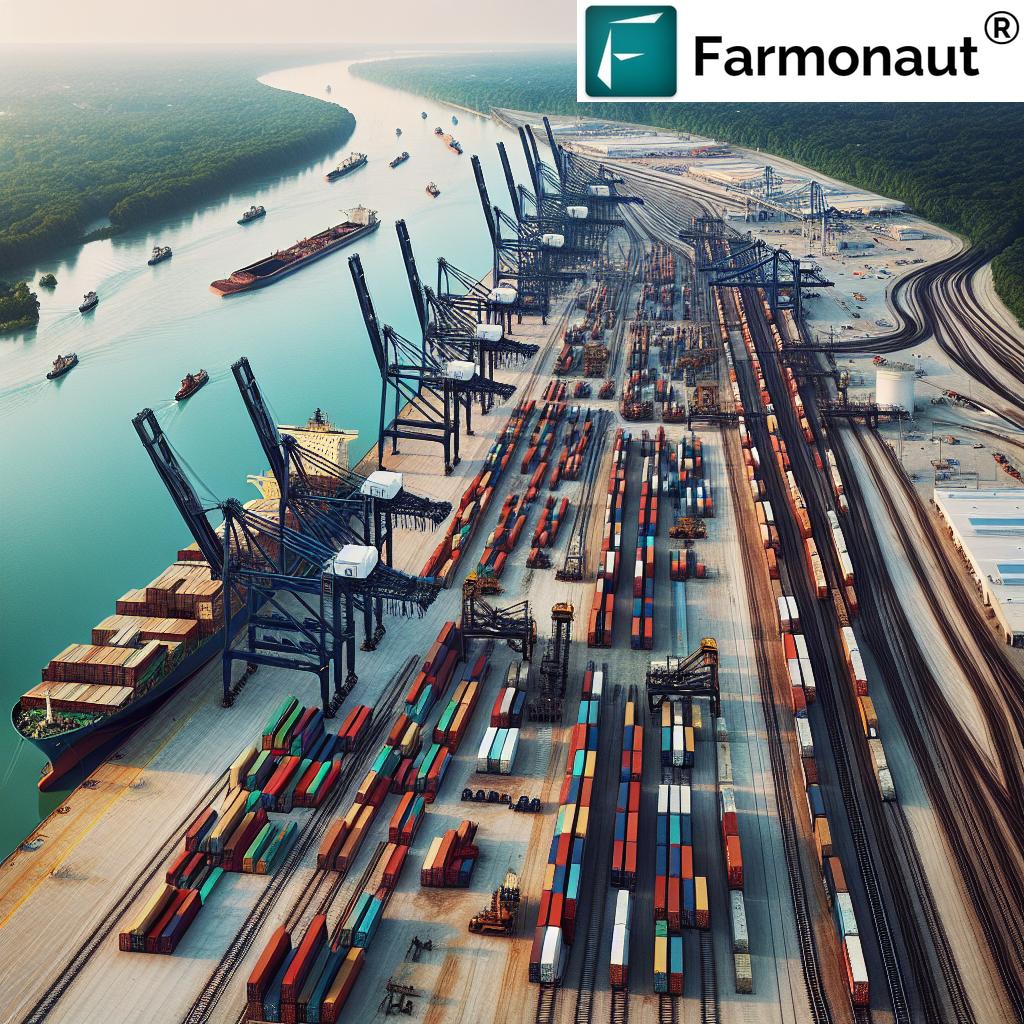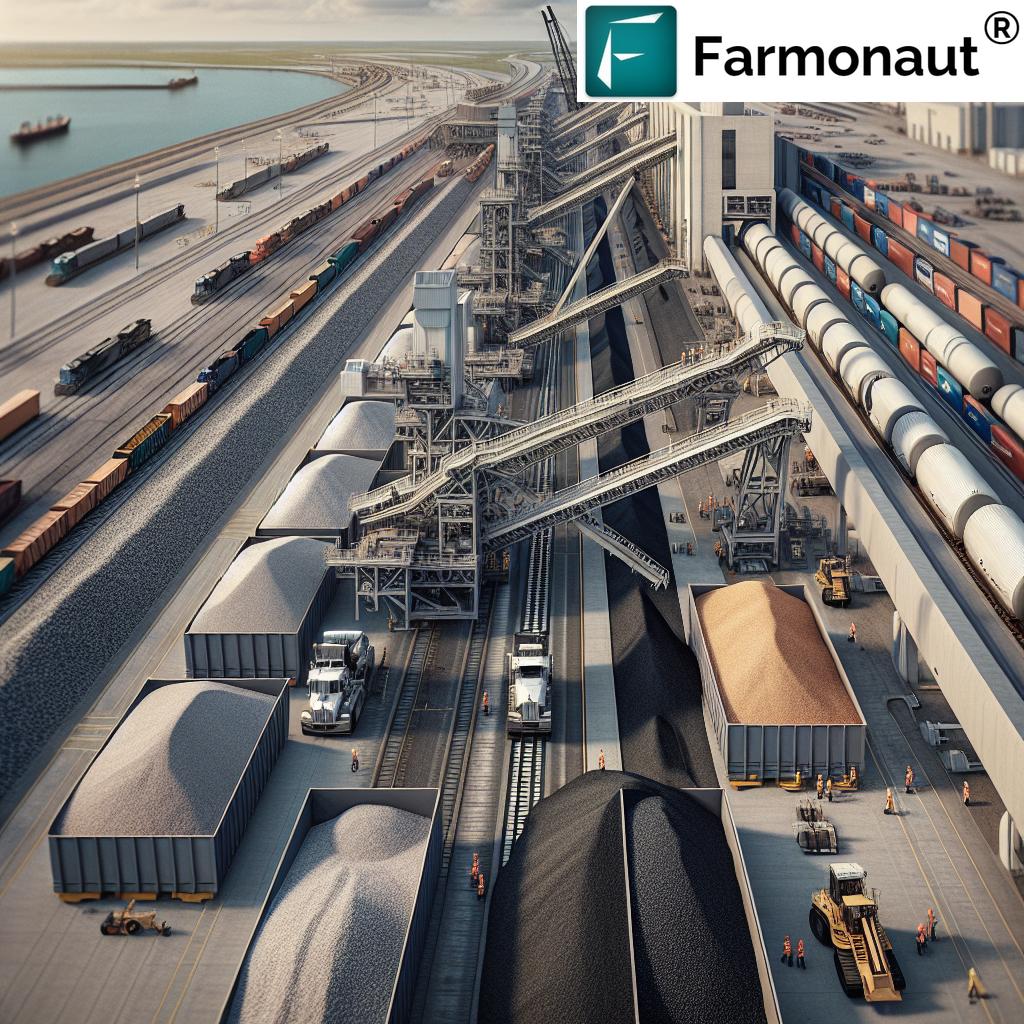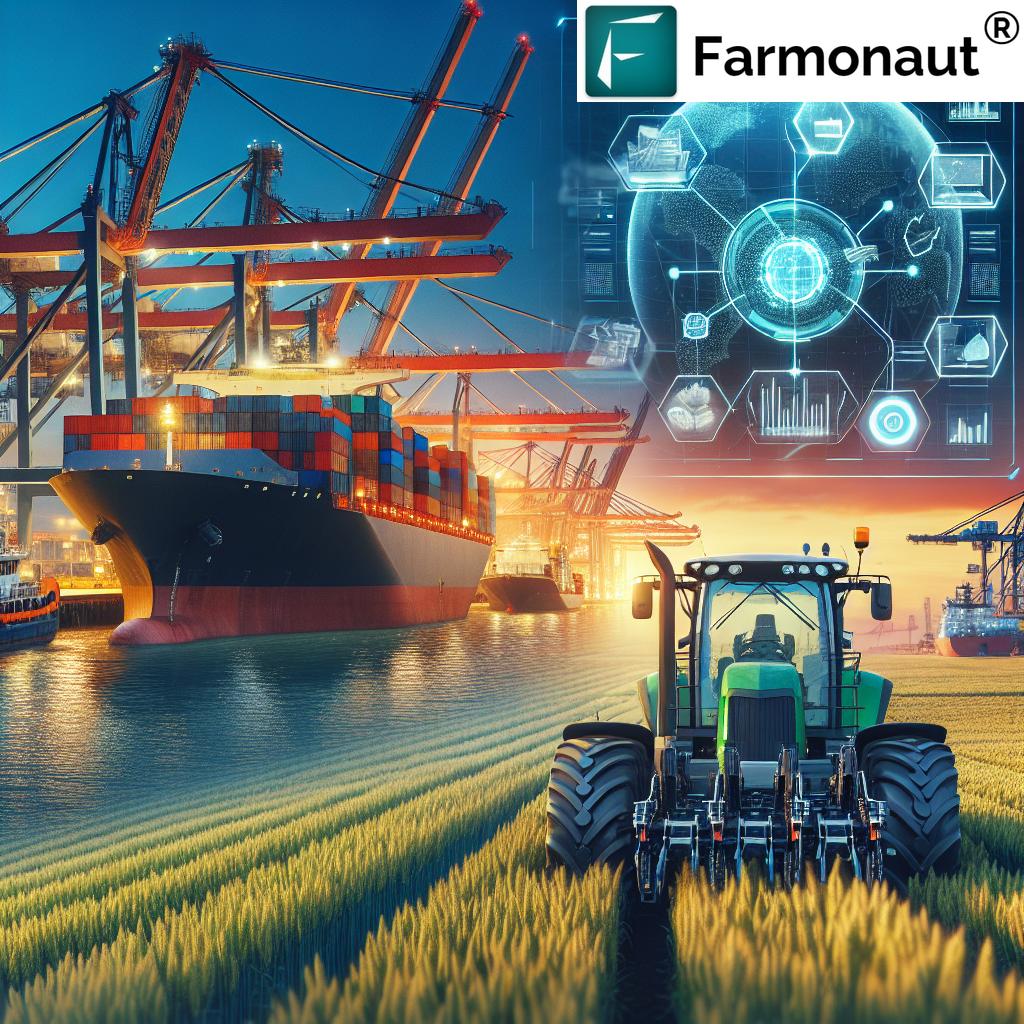Indiana Ports Reach 13 Million Tons: Economic Impact Soars with Record Cargo Volume and Infrastructure Investments

“Indiana’s ports shipped 13 million tons of cargo in 2024, supporting 49,000 jobs and generating $8.7 billion annually.”
We’re thrilled to share some exciting news about the remarkable achievements of Indiana’s ports in 2024. The Hoosier State has once again proven its critical role in maritime transportation and economic growth, reaching an impressive milestone of 13 million tons of cargo shipped. This accomplishment marks the second-highest annual volume in the port authority’s 60-year history, showcasing the state’s resilience and adaptability in the face of global economic challenges.
In this comprehensive analysis, we’ll delve into the factors driving this surge in Indiana cargo volume, explore the significant expansions and investments across the state’s three ports, and examine the far-reaching economic impact of these developments. From agricultural exports to steel shipments and bulk commodity shipping, we’ll uncover how Indiana’s maritime infrastructure investments are shaping the state’s future and driving economic prosperity.
Record-Breaking Cargo Volume: A Testament to Indiana’s Economic Strength
The 13 million tons of cargo shipped through Indiana’s ports in 2024 represents a 3% increase from the previous year, continuing a four-year streak of growth for the statewide port authority. This achievement is second only to the record set in 2018 when 14.8 million tons were shipped. The consistent upward trend in cargo volume is a clear indicator of Indiana’s robust economy and the vital role its ports play in facilitating trade and commerce.
Jody Peacock, CEO of Ports of Indiana, emphasized the significance of this milestone, stating, “We have world-class companies operating at our three ports, and their increased use of our barge, ship, and rail services is a good indicator for Indiana’s economy.” This statement underscores the symbiotic relationship between the ports and the businesses they serve, highlighting how maritime infrastructure supports and drives economic growth across various sectors.
Key Drivers of Growth: Agriculture, Coal, and Steel
The impressive cargo volume achieved in 2024 was primarily driven by three key sectors: agriculture, coal, and steel. These industries accounted for approximately 85% of the total cargo shipped through Indiana’s ports, demonstrating their critical importance to the state’s economy. Let’s take a closer look at each of these sectors and their contributions to the record-breaking year:
- Agricultural Exports: Indiana’s robust agricultural sector continued to be a major contributor to port activity. Grain, soy products, and dried distillers grains were among the top commodities shipped through the state’s ports. The strong performance in agricultural exports not only benefits farmers but also supports a wide range of related industries, from food processing to transportation.
- Coal Shipments: Despite ongoing changes in the energy landscape, coal remained a significant component of Indiana’s port cargo. In 2024, coal shipments reached 3.7 million tons, making it the highest-volume commodity moving through the state’s ports. This underscores the continued importance of coal to Indiana’s energy sector and industrial base.
- Steel-Related Shipments: The steel industry, a cornerstone of Indiana’s manufacturing sector, contributed significantly to the record cargo volume. With 2.9 million tons of steel-related shipments, it was the second-highest volume commodity after coal. This robust performance reflects the strength of Indiana’s steel industry and its vital role in supporting manufacturing throughout the Midwest.
Other notable commodities that contributed to the impressive cargo volume included fertilizer, minerals, ethanol, and road salt. The diversity of products moving through Indiana’s ports underscores the state’s economic versatility and its importance as a logistics hub for the entire region.
Infrastructure Investments: Laying the Foundation for Future Growth
“Over $200 million was invested in expanding Ohio River shipping terminals across Indiana’s three ports.”
A key factor in Indiana’s port success story is the significant investment in infrastructure and expansion projects. In 2024, public and private investments into the state’s three ports totaled more than $200 million. This substantial influx of capital has positioned Indiana’s ports for continued growth and increased efficiency in the years to come.
The investments encompassed a wide range of projects, including:
- Four company expansions at existing port facilities
- Three new companies establishing operations at the ports
- Six federal grant projects supporting critical infrastructure improvements
These investments not only enhance the ports’ operational capabilities but also create new jobs and business opportunities throughout the state. By continually upgrading and expanding its maritime infrastructure, Indiana is ensuring that its ports remain competitive and capable of meeting the evolving needs of global trade.
Indiana River & Rail Terminals: A Game-Changer for Ohio River Shipping
One of the most exciting developments in 2024 was the launch of Indiana River & Rail Terminals, which has quickly become the largest general cargo operation on the Ohio River. This innovative venture has already made a significant impact on cargo shipments, with annual volumes increasing by an impressive 48% at Mount Vernon and 12% at Jeffersonville.
The success of Indiana River & Rail Terminals was bolstered by a $16 million federal grant – the largest ever received by Ports of Indiana – to build a new rail yard. This investment in rail infrastructure is crucial for enhancing multimodal transportation capabilities and improving the efficiency of cargo movement between water, rail, and road.
The integration of advanced rail facilities with existing port infrastructure creates a powerful synergy that benefits businesses across Indiana and the broader Midwest region. By offering seamless connections between different modes of transportation, Indiana River & Rail Terminals is helping to reduce logistics costs, improve supply chain efficiency, and open up new market opportunities for Indiana businesses.
International Connections: Exploring New Trade Routes

In an exciting development for Indiana’s international trade prospects, 2024 saw the announcement of a memorandum of understanding between the Ports of Indiana and the Port of Cork in Ireland. This agreement aims to explore the establishment of express container shipping between the two ports, potentially opening up new trade routes and opportunities for Indiana businesses.
The significance of this potential partnership is underscored by the fact that Ireland is Indiana’s largest importer, with shipments totaling $20.9 billion in 2024. By establishing direct container shipping routes between Indiana and Ireland, businesses on both sides of the Atlantic could benefit from reduced transit times, lower shipping costs, and increased trade efficiency.
This initiative demonstrates Indiana’s commitment to expanding its global reach and strengthening its position as a key player in international trade. As we move forward, the potential for increased trade with Ireland and other European markets could create new opportunities for growth and diversification across various sectors of Indiana’s economy.
Economic Impact: Driving Prosperity Across Indiana
The success of Indiana’s ports extends far beyond the waterfront, generating significant economic benefits throughout the state. According to a 2023 economic impact study conducted by leading maritime economist Martin Associates, the business activities associated with Ports of Indiana have a profound and wide-reaching effect on Indiana’s economy:
- Support for over 49,000 jobs across the state
- Generation of $8.7 billion annually for Indiana’s economy
- $3.5 billion in annual wages
- $536 million in state and local taxes
These figures highlight the critical role that Indiana’s ports play in driving economic prosperity, creating job opportunities, and generating revenue for essential public services. The ripple effects of port activities touch nearly every corner of the state, from manufacturing and agriculture to retail and professional services.
Indiana Ports: A Vital Link in the Supply Chain
Indiana’s strategic location at the crossroads of America, combined with its extensive network of waterways, railroads, and highways, positions the state as a crucial hub in the national and global supply chain. The state’s three ports – Burns Harbor on Lake Michigan, and Mount Vernon and Jeffersonville on the Ohio River – provide businesses with efficient access to domestic and international markets.
The diversity of commodities handled by Indiana’s ports reflects the state’s economic versatility and its importance to various industries:
- Agriculture: Indiana’s ports play a vital role in exporting the state’s agricultural products, including grain, soybeans, and corn. The efficient handling and shipping of these commodities support Indiana’s farming communities and contribute to global food security.
- Manufacturing: The ports’ ability to handle large volumes of steel and other raw materials is crucial for Indiana’s manufacturing sector. This efficient supply chain helps maintain the state’s competitive edge in industries such as automotive, aerospace, and machinery production.
- Energy: Coal shipments through Indiana’s ports support the state’s energy sector and help meet the power needs of businesses and households across the region.
- Construction: The import of materials like road salt and minerals through the ports supports Indiana’s construction industry and infrastructure maintenance efforts.
By providing efficient and cost-effective transportation options for these diverse industries, Indiana’s ports help businesses reduce logistics costs, improve supply chain reliability, and compete more effectively in global markets.
Looking Ahead: Future Growth and Opportunities
The record-breaking performance of Indiana’s ports in 2024 sets a strong foundation for future growth and development. As we look ahead, several factors are likely to drive continued expansion and economic impact:
- Ongoing Infrastructure Investments: The substantial investments made in 2024 are just the beginning. Continued upgrades to port facilities, rail connections, and multimodal capabilities will further enhance Indiana’s logistics advantages.
- Expansion of International Trade: The potential establishment of express container shipping with Ireland could open doors to new European markets, diversifying Indiana’s trade partnerships and creating new opportunities for businesses across the state.
- Technological Advancements: The integration of cutting-edge technologies, such as automated cargo handling systems and digital logistics platforms, could further improve efficiency and competitiveness at Indiana’s ports.
- Sustainability Initiatives: As global focus on environmental sustainability grows, Indiana’s ports are well-positioned to lead in adopting green technologies and practices, potentially attracting environmentally conscious businesses and investors.
These future developments promise to reinforce Indiana’s position as a logistics powerhouse and drive continued economic growth across the state.
Indiana Ports Economic Impact Comparison
| Economic Indicator | Port of Indiana-Burns Harbor | Port of Indiana-Jeffersonville | Port of Indiana-Mount Vernon |
|---|---|---|---|
| Annual Cargo Volume (tons) | 3.5 million | 2.8 million | 6.7 million |
| Jobs Supported | 15,000 | 12,000 | 22,000 |
| Economic Impact ($ billion) | 2.5 | 2.0 | 4.2 |
| Infrastructure Investments ($ million) | 75 | 60 | 65 |
| Major Industries Served | Steel, Agriculture, Manufacturing | Automotive, Agriculture, Construction | Energy, Agriculture, Chemicals |
As we can see from this comparison, each of Indiana’s ports plays a unique and vital role in the state’s economy. The Port of Indiana-Mount Vernon stands out as the largest in terms of cargo volume and economic impact, reflecting its strategic location on the Ohio River and its importance to the energy and agricultural sectors. However, the ports at Burns Harbor and Jeffersonville also make substantial contributions, particularly in supporting manufacturing and automotive industries.
Conclusion: Indiana’s Ports – Powering Economic Growth and Opportunity
The remarkable achievements of Indiana’s ports in 2024 underscore their critical importance to the state’s economy and their role as drivers of growth and prosperity. With 13 million tons of cargo shipped, supporting 49,000 jobs, and generating $8.7 billion in economic impact, the ports have proven their resilience and adaptability in the face of global economic challenges.
The success of Indiana’s ports is not just a story of numbers and statistics – it’s a testament to the hard work, innovation, and vision of countless individuals and organizations across the state. From the port workers and logistics professionals who keep cargo moving efficiently, to the businesses that rely on the ports for their operations, to the state and local leaders who champion infrastructure investments, this achievement is truly a collective effort.
As we look to the future, the continued growth and development of Indiana’s ports promise to create new opportunities for businesses, workers, and communities throughout the state. By leveraging its strategic location, world-class infrastructure, and commitment to innovation, Indiana is well-positioned to remain a leader in maritime commerce and a vital hub in the global supply chain.
The success of Indiana’s ports serves as a powerful reminder of the importance of investing in critical infrastructure and the transformative impact it can have on a state’s economy. As Indiana continues to build on this momentum, we can expect to see even greater achievements and opportunities emerge from its thriving maritime sector.
FAQ Section
- Q: What was the total cargo volume shipped through Indiana’s ports in 2024?
A: Indiana’s ports shipped 13 million tons of cargo in 2024, marking the second-highest annual volume in the port authority’s 60-year history. - Q: How many jobs are supported by Indiana’s ports?
A: According to the 2023 economic impact study, the business activities associated with Ports of Indiana support more than 49,000 jobs across the state. - Q: What are the main commodities shipped through Indiana’s ports?
A: The highest-volume commodities include coal (3.7 million tons), steel (2.9 million tons), grain, soy products, fertilizer, minerals, ethanol, road salt, and dried distillers grains. - Q: How much was invested in Indiana’s ports in 2024?
A: Public and private investments into Indiana’s three ports totaled more than $200 million in 2024. - Q: What is the economic impact of Indiana’s ports on the state’s economy?
A: Ports of Indiana’s business activities generate $8.7 billion annually for the state’s economy, including $3.5 billion in annual wages and $536 million in state and local taxes. - Q: What new developments occurred at Indiana’s ports in 2024?
A: Key developments included the launch of Indiana River & Rail Terminals, the largest general cargo operation on the Ohio River, and a memorandum of understanding with the Port of Cork in Ireland to explore express container shipping. - Q: How do Indiana’s ports contribute to international trade?
A: Indiana’s ports facilitate international trade by providing efficient access to global markets. In 2024, shipments totaling $20.9 billion were imported from Ireland alone, making it Indiana’s largest importer. - Q: What industries benefit most from Indiana’s ports?
A: The ports play a crucial role in supporting Indiana’s manufacturing, energy, and agriculture sectors, which together accounted for about 85% of cargo shipments in 2024.
Enhancing Agricultural Productivity with Farmonaut
While we’ve explored the significant role of Indiana’s ports in supporting the state’s agricultural sector, it’s worth noting how modern technology is further enhancing agricultural productivity and efficiency. Farmonaut, a pioneering agricultural technology company, offers advanced, satellite-based farm management solutions that can complement the logistical advantages provided by Indiana’s robust port infrastructure.
Farmonaut’s platform leverages satellite imagery, artificial intelligence, and machine learning to address various agricultural challenges. By providing real-time crop health monitoring, personalized farm advisory services, and resource management tools, Farmonaut enables farmers to make data-driven decisions that can optimize crop yields and reduce resource wastage.
For Indiana’s agricultural sector, which relies heavily on the state’s ports for exporting products like grain and soybeans, integrating technologies like Farmonaut could further enhance competitiveness in global markets. By improving crop management and increasing yields, farmers can maximize the value of the efficient transportation networks provided by Indiana’s ports.
To learn more about how Farmonaut’s solutions can benefit agricultural operations, visit their website or explore their mobile apps:
For developers interested in integrating Farmonaut’s satellite and weather data into their own systems, check out the Farmonaut API and the API Developer Docs.
Earn With Farmonaut
Earn 20% recurring commission with Farmonaut’s affiliate program by sharing your promo code and helping farmers save 10%. Onboard 10 Elite farmers monthly to earn a minimum of $148,000 annually—start now and grow your income!
Farmonaut Subscriptions
By leveraging advanced agricultural technologies alongside Indiana’s world-class port infrastructure, the state’s agricultural sector is well-positioned to maintain its competitive edge and continue driving economic growth for years to come.




















